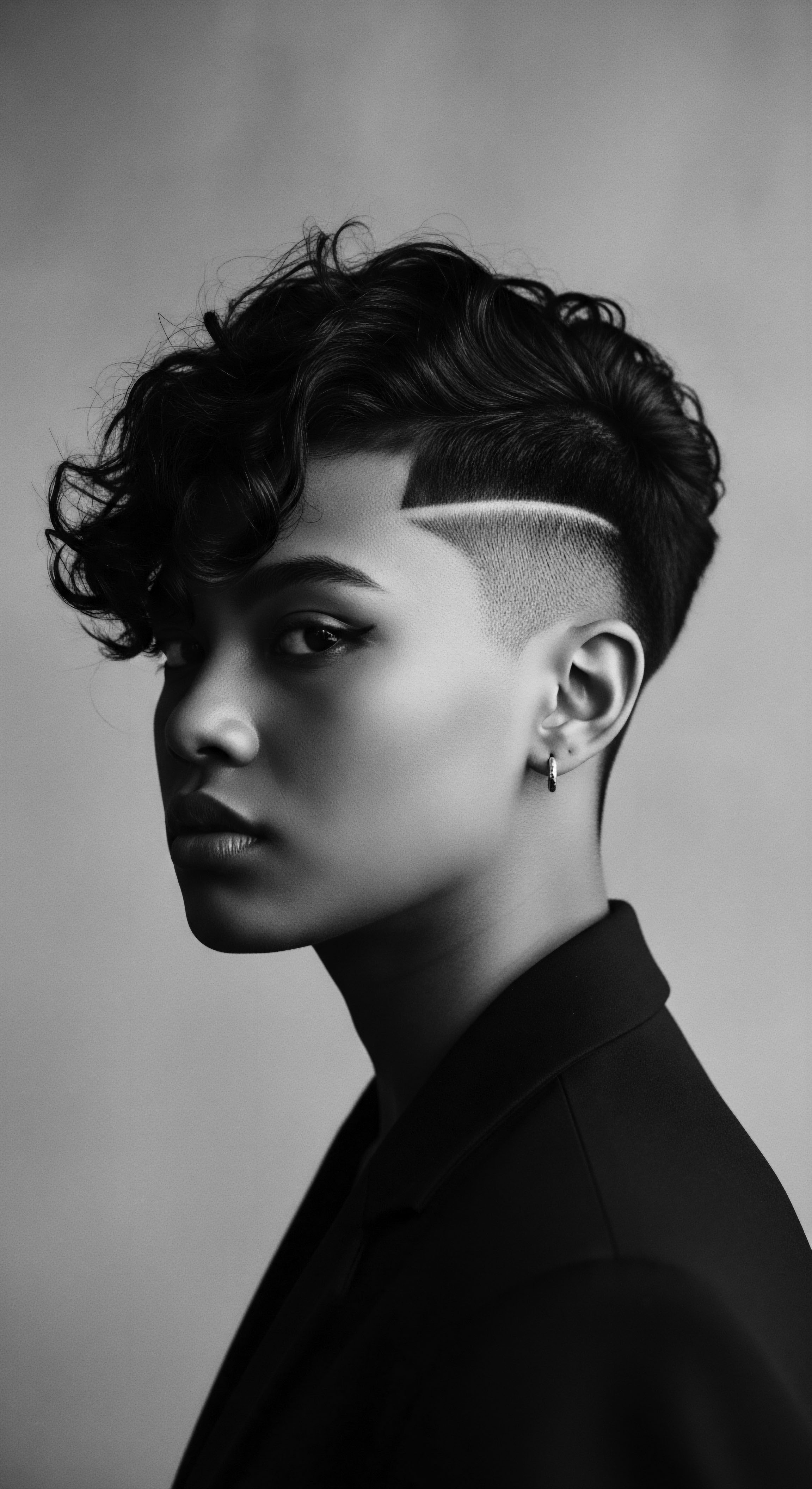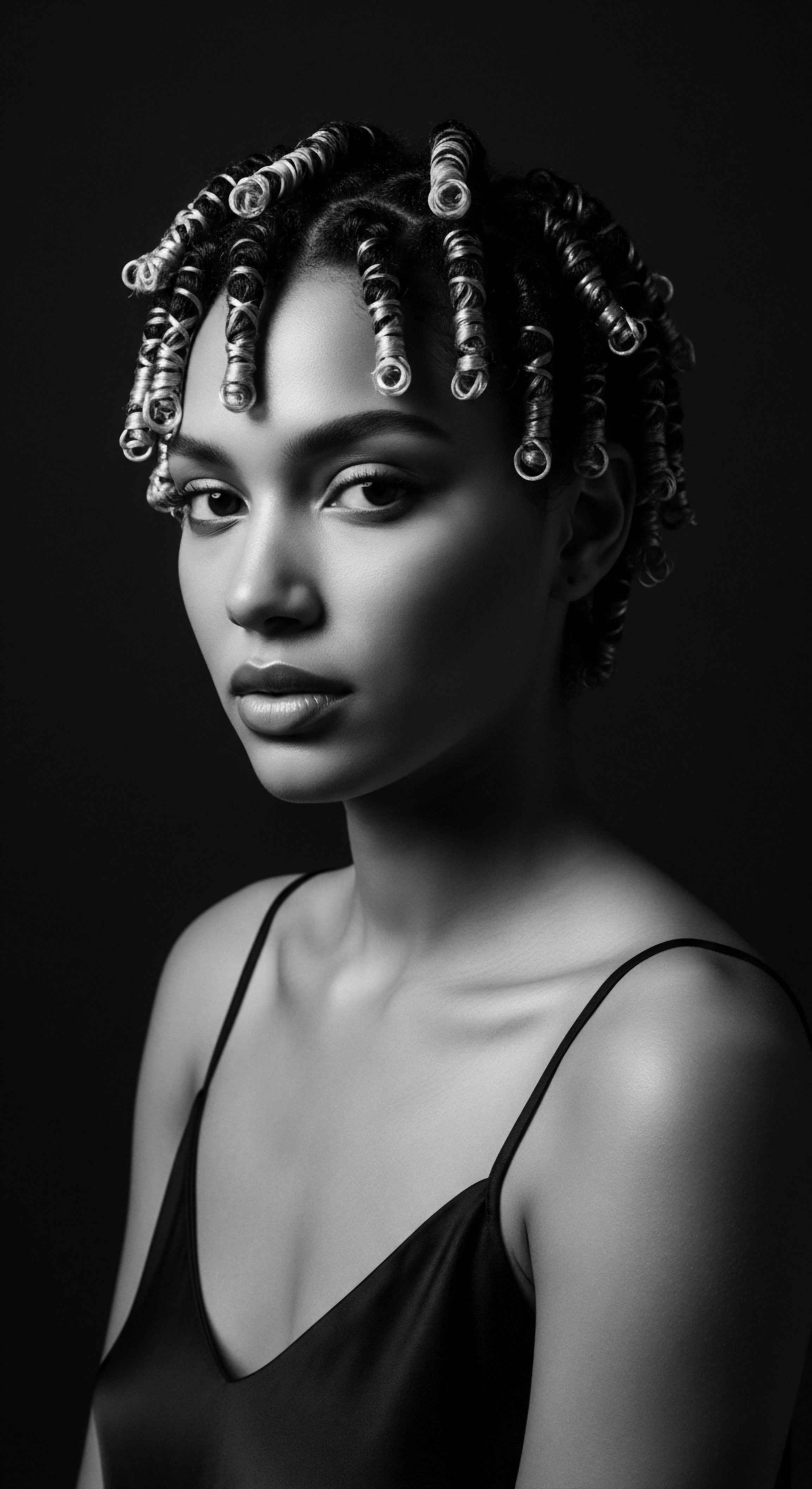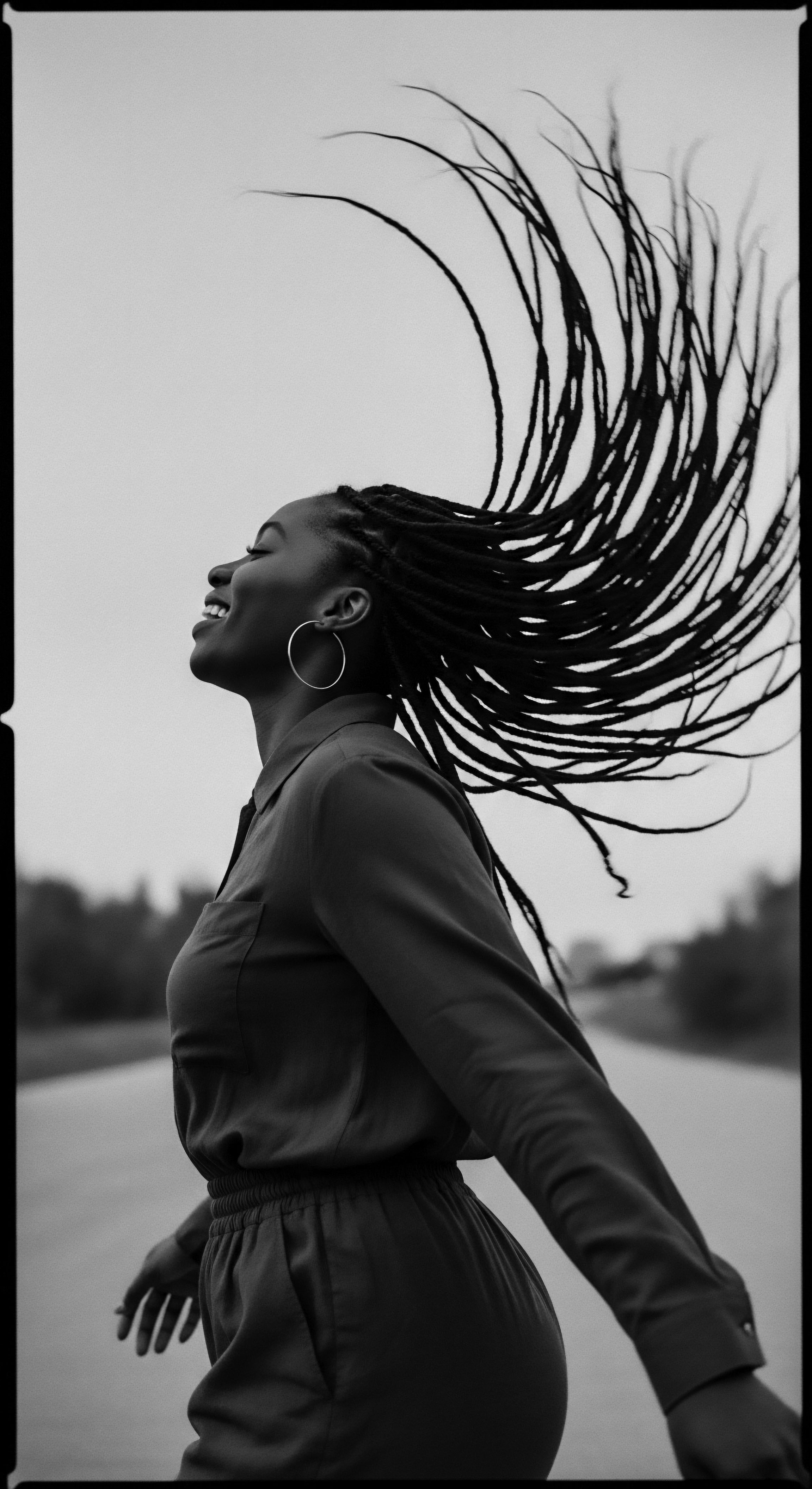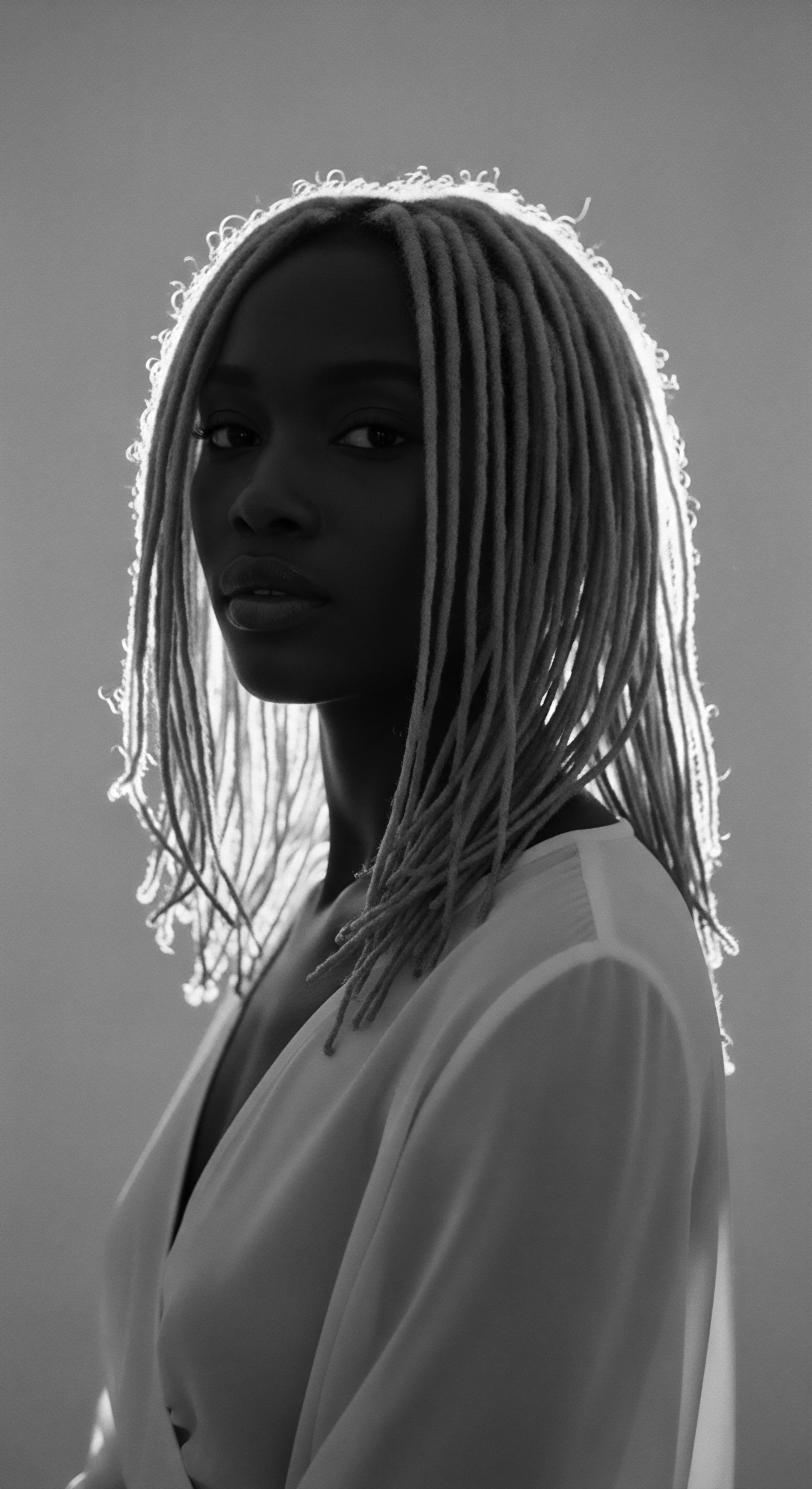
Roots
Consider for a moment the very strands of hair that crown a head. They are more than protein; they carry whispers of ancestors, echoes of sun-drenched lands, and the resilience of a spirit that refuses to be diminished. When we speak of Textured Hair Heritage, we are not simply discussing biology. We are speaking of a living legacy, a profound connection to origins, and a story written not in ink, but in every coil, kink, and curl.
For enslaved people, transported across vast waters, their hair became an undeniable truth of who they were, a testament to what could not be stripped away. It was a silent, powerful assertion of identity in a world bent on its erasure.
The anatomy of textured hair, often characterized by its elliptical follicle shape, results in a helix-like structure that coils upon itself. This unique architecture provides natural volume and strength, a gift of adaptation to diverse African climates. Before the brutal transatlantic voyages, in countless African societies, hair was a profound visual lexicon. A person’s hairstyle communicated their age, marital status, social standing, religious beliefs, and even tribal identity.
Intricate braiding, coiling, and adornment were not merely aesthetic pursuits; they were acts of communal storytelling, rites of passage, and spiritual expressions. The deep respect for hair in these ancestral practices meant that hair care was often a communal activity, a time for bonding and the transmission of wisdom.
When Africans were forcibly taken from their homelands, one of the first acts of dehumanization was often the shaving of their heads. This act aimed to sever their ties to identity, culture, and the sacred practices tied to their hair. Yet, even in the harrowing conditions of forced servitude, the spirit of this heritage persisted.
As hair regrew, often with limited tools and resources, enslaved people found ways to care for and style it, reclaiming a piece of their lost world. This was an act of quiet defiance, a way to hold onto self in the face of brutal oppression.
Textured hair, with its unique biological structure and profound cultural significance, served as an enduring symbol of identity and silent resistance for enslaved people, despite efforts to erase their heritage.

What Did Ancestors Know of Hair’s Nature?
Ancestral knowledge of textured hair went beyond simple styling; it embodied a deep understanding of its needs and characteristics. Without modern scientific labels, African communities developed sophisticated systems of care that honored the hair’s coiled structure. They intuitively understood porosity, moisture retention, and the hair’s susceptibility to breakage, devising methods that countered environmental stressors.
For instance, the use of naturally occurring oils and butters, such as shea butter and coconut oil, provided essential moisture and protection against harsh sun and dry conditions. These practices were passed down through generations, living repositories of wisdom that safeguarded hair health and, by extension, cultural continuity.
The varied classifications of textured hair today, while helpful for modern care, sometimes echo the biases of colonial perceptions. Historically, hair was seen as a marker of identity, not a hierarchy of “good” or “bad” texture. During slavery, a cruel system of colorism and texturism emerged, where straighter hair was sometimes associated with perceived “privileges” within the oppressive structure.
This external imposition stood in stark contrast to pre-colonial African societies, where the full spectrum of hair types was celebrated as a natural aspect of human diversity. The very lexicon used to describe textured hair today, while evolving, still grapples with the historical burden of these imposed negative associations.

Understanding Hair’s Innate Rhythms
Hair growth cycles, from the active anagen phase to the resting telogen phase, are universal. Yet, for enslaved people, these cycles were profoundly affected by extreme duress. Malnutrition, chronic stress, and grueling labor took a severe toll on physical health, directly impacting hair growth and vitality. Despite these challenges, the simple act of maintaining hair, even in its most basic forms like neat braids, was an assertion of self-worth.
It demonstrated an innate understanding that personal care, however minimal, was a form of dignity. This quiet perseverance speaks to a profound ancestral wisdom ❉ recognizing the body, including its hair, as a sacred vessel deserving of care, even when external forces sought to desecrate it.

Ritual
The forced displacement of millions of Africans across the Atlantic, a period known as the Middle Passage, marked a deliberate assault on their humanity. Upon arrival, enslavers often shaved heads, a symbolic act meant to strip individuals of their cultural markers and communal bonds. Yet, out of this profound violation, a new form of cultural expression and profound resistance arose. The act of tending to one’s hair, and to the hair of others, became a ritual of survival, a clandestine school where ancestral practices were whispered into being, transforming necessity into powerful assertion.
Traditional African styling practices, steeped in communal bonds and spiritual significance, adapted under the brutal realities of slavery. Protective styles, which prior to enslavement served to convey status or prepare for ceremonies, became essential for preserving hair health in harsh working conditions and minimizing manipulation. Braids and twists, often tightly plaited against the scalp, offered practical solutions for managing hair without proper tools or products.
These methods also served as a silent, yet powerful, connection to a lost homeland and a shared heritage. The very act of forming a braid or twisting a coil became a defiant ritual, an act of self-care and cultural remembrance in a system designed to deny both.
From enforced bareness, textured hair rituals became a secret language of resilience, adapting ancient styling practices into tools of quiet defiance and cultural memory.

How Did Hair Become a Map to Freedom?
Perhaps one of the most powerful and poignant examples of textured hair as a symbol of resistance comes from the ingenuity of enslaved Africans in the Americas. Stories recount how certain hairstyles, particularly cornrows, were used to secretly convey messages and even maps for escape routes. This practice is most documented in Colombia, where an African king, Benkos Biohó, who had escaped slavery in the early 17th century, founded San Basilio de Palenque, the first free village in the Americas of African heritage. Biohó and the community he built are credited with devising an intelligence network where women braided coded messages into their hair.
Specific patterns of cornrows might indicate pathways through forests, the location of water sources, or even rendezvous points. One hairstyle, known as ‘departes’ (meaning “to depart”), was reportedly composed of thick braids tied into buns on top of the head, signaling plans to escape. The coiled nature of textured hair made it an ideal, discreet vessel for these covert messages.
Not only did these intricate designs serve as navigational guides, but the braids also became clandestine storage spaces. Women would conceal seeds within their plaits, ensuring a means for survival and future sustenance once they reached freedom. Tiny gold nuggets, sometimes pilfered from mines, were also hidden in the hair, offering a precious resource for establishing new lives away from oppression.
This remarkable ingenuity speaks to the extraordinary resilience and collective spirit of those who fought for freedom, using their very bodies as instruments of liberation. While historical documentation from the perspective of the enslaved is scarce due to the nature of their experiences, oral histories passed down through Afro-Colombian communities lend powerful credence to these accounts, upholding them as a central part of their shared heritage.

Tools of Tenacity and Cultural Continuity
The tools available to enslaved people for hair care were often rudimentary, crafted from necessity. Pieces of bone, wood, or discarded metal might serve as combs. Animal fats, cooking oils, or butter were repurposed to moisturize and protect hair from the harsh sun and labor.
Despite the scarcity, the very act of using these tools, however humble, was a continuation of ancestral practices.
- Combs and Picks ❉ Often fashioned from found materials, these were essential for detangling and creating partings, mirroring the functionality of more elaborate combs from their homelands.
- Fats and Oils ❉ Natural substances applied to seal in moisture, guarding against the dryness induced by forced labor and lack of proper resources.
- Head Wraps ❉ Though sometimes imposed as a sign of subjugation, these head coverings were reclaimed by enslaved women as a means of protecting hair, asserting cultural identity, and even conveying unspoken messages. The way a head wrap was tied, the fabrics chosen, all could speak volumes to those who understood the silent language of shared heritage.
| Historical Hair Use Braiding |
| Traditional African Context Identity marker, social status, spiritual connection, communal bonding. |
| Resistance Context in Slavery Covert communication, mapping escape routes, hiding small goods like seeds or gold. |
| Historical Hair Use Hair Maintenance |
| Traditional African Context Ritualistic, using traditional oils and tools for health and beauty. |
| Resistance Context in Slavery Act of self-care, preserving dignity, retaining connection to self and heritage amidst dehumanization. |
| Historical Hair Use Head Coverings |
| Traditional African Context Symbol of social standing, modesty, spiritual protection, cultural expression. |
| Resistance Context in Slavery Reclaimed symbol of identity, protective measure, subtle defiance against imposed subjugation. |
| Historical Hair Use These practices highlight the profound adaptation of ancestral hair traditions into powerful, multi-layered acts of resistance during enslavement. |

Relay
The enduring spirit of resistance through textured hair, born in the crucible of enslavement, continues to reverberate through generations, shaping contemporary understandings of heritage, identity, and care. The subtle acts of defiance practiced by ancestors were not isolated incidents; they were the seeds from which a broader consciousness of Black and mixed-race hair pride would eventually blossom. This relay of ancestral wisdom, often passed through oral tradition and lived experience, forms the backbone of modern hair wellness, intertwining science with centuries of cultural insight.
Understanding the profound historical context of hair as a symbol of defiance helps us build more holistic hair care regimens today. Our ancestors, through trial and profound environmental observation, learned how to nourish and protect their hair with limited resources. Their methods, though constrained by brutal circumstances, laid a foundation for understanding textured hair’s need for moisture, gentle handling, and protection.
Modern science now validates many of these traditional approaches, showing how certain ingredients and techniques work on a molecular level to support the hair’s unique structure. This blend of ancient wisdom and contemporary knowledge allows for truly personalized care.
The resistance woven into textured hair’s past now informs modern holistic care, linking ancestral methods with scientific understanding to foster wellness and pride.

How Do Ancestral Practices Guide Modern Hair Care?
The quest for effective textured hair care today often leads back to the very customs practiced by our forebears. Consider the simple wisdom of protective styling, a concept prevalent in many African cultures long before its contemporary resurgence. These styles—braids, twists, and covered hair—minimized manipulation, shielded strands from environmental stressors, and helped retain moisture. This deep-seated knowledge of preservation, honed over centuries of living in diverse climates, offers blueprints for contemporary routines aimed at reducing breakage and promoting length retention.
The night, a time often associated with rest, historically became a crucial period for protecting hair. For enslaved individuals, a head covering, whether a simple cloth or a more elaborate wrap, served practical purposes ❉ protecting hair from dirt, preventing tangling during sleep, and maintaining a sense of personal presentation. This practice, a subtle yet persistent continuation of self-respect, evolved into the tradition of wearing bonnets or satin scarves.
From a scientific viewpoint, the smooth surface of satin or silk minimizes friction, preventing frizz and preserving the hair’s delicate cuticle, thereby supporting moisture retention. This seemingly simple nighttime ritual carries the weight of generations, a quiet continuity of care passed from elder to youth.

What Does Hair Tell Us About Our Collective Past?
Hair, with its inherent biological characteristics, became a canvas upon which the brutal realities of enslavement were etched, yet it also became a resilient medium for defiance. The very texture of African hair was pathologized by Eurocentric beauty standards during slavery, leading to discrimination and the belief within the enslaved community that their natural hair was inferior. This historical prejudice gave rise to practices aimed at altering hair texture, often through harmful chemical processes, in an attempt to conform to imposed norms.
However, the narrative of hair resistance runs deeper. Beyond the hidden maps, hair served as a constant, visual reminder of African identity that could not be fully erased. The simple persistence of wearing cornrows or cultivating certain styles, even under oppressive conditions, was a direct refutation of the enslavers’ attempts to strip away identity. This cultural preservation, a quiet rebellion, underscored the innate human need for self-expression and connection to one’s roots.
For instance, one historical observation notes that hair texture sometimes superseded even skin color as a determinant of treatment during slavery, with individuals possessing kinkier hair often relegated to harsher field labor, while those with straighter textures might be assigned domestic duties. This cruel system further cemented the idea that hair, down to its very curl pattern, was a marker within the oppressive social hierarchy. Yet, even as external forces sought to control, manipulate, and devalue, the spirit of ancestral wisdom persisted.
- Oral Histories ❉ Accounts passed down through generations, like those of the Afro-Colombian communities regarding cornrows as maps, preserve the memory of hair’s role in covert resistance.
- Symbolic Meanings ❉ Specific braids or adornments, though often hidden, continued to carry coded messages about identity, marital status, or even religious beliefs, maintaining a connection to pre-colonial systems of communication.
- Resilience of Practice ❉ Despite deprivation of traditional tools and products, enslaved people ingeniously adapted, using available materials to care for their hair, signifying an unbroken thread of self-worth and cultural continuity.
The narrative of textured hair during enslavement is thus a powerful lens through which to understand profound human resilience. It shows us how a biological feature, steeped in cultural meaning, transformed into a potent vehicle for covert communication, a marker of unbreakable identity, and a profound assertion of self against systematic dehumanization. This lineage of resistance continues to ground the contemporary pride in textured hair, reminding us that its heritage is one of profound strength and a constant refusal to be silenced.

Reflection
The journey through the heritage of textured hair, particularly its role as a symbol of resistance for enslaved people, leaves us with a sense of profound reverence. Each coil, every twist, holds within it a living archive of pain, survival, and undeniable triumph. It is a testament to the human spirit’s unwavering will to retain self, even when systematic forces conspire to dismantle it. The threads of ancestry run deep, weaving through time, connecting the wisdom of ancient African communities to the fierce determination of those who endured the brutality of the transatlantic slave trade.
The ‘Soul of a Strand’ ethos acknowledges that textured hair is far more than a physical attribute. It is a carrier of stories, a vessel of identity, and a living monument to the ingenuity and resilience of Black and mixed-race peoples. From the hidden maps braided into cornrows that guided journeys to freedom, to the simple, daily acts of care that defied a world attempting to erase dignity, hair became an intimate battleground, and a source of quiet victory.
This history asks us to look beyond the surface, to recognize the profound messages encoded within the seemingly ordinary, and to honor the ancestral practices that safeguarded not just hair, but the very essence of personhood. As we continue to learn, care for, and celebrate textured hair in its myriad forms today, we participate in this enduring relay of heritage, ensuring that the legacy of resistance, self-worth, and beauty remains vibrant, unbound, and forever revered.

References
- Bogaard, C. (2022). African Slaves Used Braids to Communicate Escape Routes in Colombia. Ancient Origins .
- Byrd, A. D. & Tharps, L. R. (2014). Hair Story ❉ Untangling the Roots of Black Hair in America. St. Martin’s Griffin.
- Essel, E. A. (2023). Cornrow ❉ A Medium for Communicating Escape Strategies during the Transatlantic Slave Trade Era ❉ Evidences from Elmina Castle and Centre for National Culture in Kumasi. ResearchGate .
- Greene, D. W. (2011). Black Women Can’t Have Blonde Hair. in the Workplace. Journal of Gender, Race and Justice, 14(2).
- Morrow, W. (1973). 400 Years Without a Comb. San Diego.
- Nabugodi, M. (2022). Afro Hair in the Time of Slavery. Studies in Romanticism .
- Patton, T. O. (2006). Hey Girl, Am I More than My Hair? ❉ African American Women and Their Struggles with Beauty, Body Image, and Hair. Routledge.
- Rivers, L. E. (2012). Rebels and Runaways ❉ Slave Resistance in Nineteenth-Century Florida. University of Illinois Press.
- Schwartz, S. B. (2017). Rethinking Palmares ❉ Slave Resistance in Colonial Brazil. Critical Readings on Global Slavery .
- Tate, S. (2017). Black Beauty ❉ African American Women and the Politics of Race and Culture. Routledge.
- Thompson, M. (2009). Black Women and the Politics of Hair. University of Pittsburgh Press.
- White, S. & White, G. (1995). Slave Hair and African American Culture in the Eighteenth and Nineteenth Centuries. The Journal of Southern History, 61(1).
